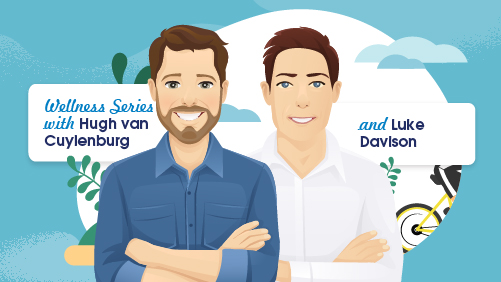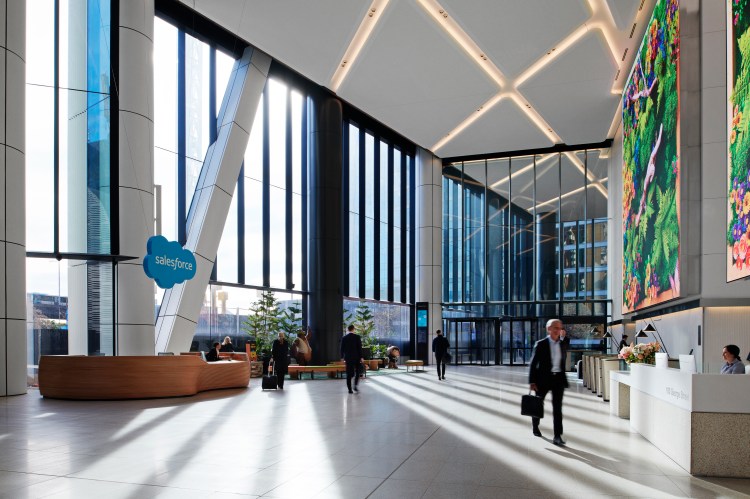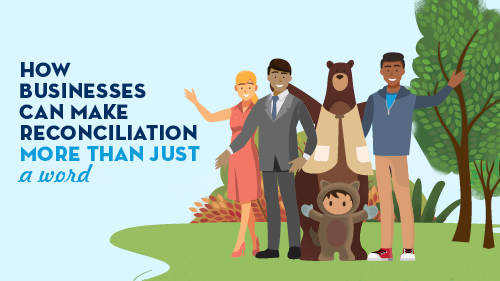Managing burnout and building resilience as a team



If you do what you love, you’ll never work a day in your life, right? Not quite. In fact, a strong sense of purpose might make it easier to ignore your limits. Before I was an Account Executive at Salesforce, I was a cyclist constantly training for my next big goal – I know all too well how tempting it can be to ignore the warning signs. The Resilience Project’s Hugh van Cuylenburg tells us how to manage burnout and build resilience as a team.
Salesforce Staff
Imagine you’re in a cycling peloton. There’s constant reinforcement and motivation to get better and do better. Now transfer that into a workplace scenario, where teamwork, collaboration and cooperation are key. Those environments are inspiring and help us do our best work, but sometimes people can push themselves too hard and ignore looming signs of burnout.
I’ll put my hand up and admit that I’ve been one of those people. Whether it’s sporting or sales, I’ve found that my biggest achievements typically coincide with some of my most serious brushes with burnout. When you’re chipping away at smaller goals every day, it can be harder to convince yourself that you’re actually improving or getting any closer to that ultimate goal.
So how can you recognise burnout, and what can you do about it? Hugh van Cuylenburg, founder of The Resilience Project, gave us some advice on managing burnout and building resilience – and why sometimes it involves telling a group of footballers, “I don’t want to be here right now.”
What Is Burnout and How Can We Recognise It?
After getting to see the similarities between sporting and corporate environments, you also realise how much burnout can vary based on our own perceptions. That means everyone’s burnout is going to look a little different, and everyone has their own background and ways of approaching things. But if you look for a single definition of burnout, exhaustion comes up a lot.
For his part, Hugh characterises burnout as having “nothing left in the tank” and warns that it isn’t just an occupational phenomenon. And recognising it in yourself or others requires tuning in to behaviour changes, he says.
Hugh says there are several signs to watch out for:
- Visible fatigue
- Being less socially engaged or mentally ‘present’
- Spending lots of extra time on your mobile, beyond the occasional break or email checking
- Eating less healthy or drinking more alcohol than usual
- Being more negative or critical toward others
He also says the fundamentals of self care – exercise, diet, sleep – start to slip. If you’re no longer making time to exercise or you’re skipping sleep to do work, these could be signs that your ‘tank’ is getting low.
This tracks with my own experiences. When it comes to elite cycling, there are so many elements that go into training: you’ve got nutrition, gym, stretching, and a whole multitude of factors to put you in the best possible position to win the race. But on top of all those factors is your ability to sit back and acknowledge how you feel. Are you listening to your body? What are you experiencing?
It’s not very different in a corporate world. You’ve got just as many factors that contribute to your success and wellbeing: family, exercise and sleep are just a few. And balancing those factors depends on being able to go to that higher level and think, “What am I experiencing? Am I more distracted? Are little things bothering me more than they normally would?”
Managing Burnout Individually
Let’s say you realise that you’re feeling burnt out. What’s next?
Hugh uses his own experience with burnout as an example. While his wife was heavily pregnant, he needed to travel to Queensland to lead a resilience workshop at a week-long football camp. What happened next shows the power of an important first step: vulnerability.
“I got in front of that group and I told them I didn’t want to be there. I told them I was exhausted and I just wanted to be with my family, that I had almost nothing to give emotionally.”
The footballers responded with an outpouring of support and empathy – an energising connection that helped Hugh make the decision to start prioritising time for recharging and recovering.
More broadly, this speaks to resilience, which Hugh explains as, “how you cultivate position emotion in your life.” This doesn’t have to be a big effort, either. For Hugh, that could be as simple as laughing and joking with his wife, even poking fun at himself.
For me, when it comes to managing my own burnout, I’ve always found it helpful to take a moment and celebrate the wins, no matter how small or large they may be. This can be harder when you’re the type of person who is always chasing that next goal, but taking stock of what you’ve already achieved can help you maintain perspective and see things through a more positive lens.
Wellness Playbook Guides
Prioritise employee wellbeing with tips from Thrive Global and Sales



Managing Burnout Together
It’s important to be aware of how we’re feeling and whether we may be burned out, but those around us have important roles to play, too. Hugh explains that noticing signs of burnout is everyone’s job. “Everyone is a leader in this area,” he says. “It’s about paying really close attention to yourself and your teammates.”
One of the most fundamental correlations I’ve seen between sport and working at Salesforce has been the importance of a team – having others there to help you and to know that everyone is working toward the same goal.
But the other big similarity is how much it helps to have someone who is able to listen. They don’t necessarily need to give feedback, even. When I was in my twenties and riding six hours a day in northern Italy and various other locations, it was crucial to be able to talk to a teammate about how we were feeling and what we were working toward. Simply confiding in a person you trust can help you come back to some sort of centre – and often it reminds you that others are experiencing their own struggles, too.
Hugh repeatedly stresses the importance of this sort of connection, and it’s one that he and his team at The Resilience Project have cultivated in a deliberate way. During Victoria’s second lockdown, when morale was low, this involved carving out formal opportunities to share how they felt. For those in senior positions, it was also crucial to model behaviour.
“We arranged opportunities to check in with each other,” he explains. “Our CEO started off by saying he had his own struggles with working from home with two young kids. He modelled it, and we never said that anyone needed to open up in the same way, but they did.”
There are a few other things that can help when others are experiencing burnout. Those in senior positions may want to offer the person space, time off, or simply an opportunity to listen and understand what’s needed. Hugh says that chipping away at certain stigmas will be important, too.
“Think about when we’re playing sport or training,” says Hugh. “If someone feels pain or notices something wrong, what do they do? They go to a physio straight away. But if something is wrong mentally or emotionally, they don’t always immediately go to a counsellor or psychologist.
“Those professionals are really like physios for our minds and hearts. I’m a generally happy person, but I see a counsellor regularly and I’m open about it. I make sure it’s in my calendar and that I’m modelling that behaviour.”
Building Resilience as a Group
Leaders have a big role to play in setting the tone and modelling behaviour. I’ve experienced this myself recently. When you’re, say, working toward the end of the financial year and everyone is feeling the pressure, it can make all the difference to hear upper management tell you, “We’re coming toward the end of the race, and I’m here to support you, no matter what your goal or your experience might be.”
Of course, leaders aren’t the only ones who can play this role. Hugh describes resilience as our ability to foster positivity and positive emotions. So how can we do that, not just individually but as a team?
Hugh has a few recommendations, and they can be kicked off by a single person:
- What went well? Using perhaps a poster or whiteboard, this activity tracks and displays successes, big or small: a free coffee, your daughter doing well at her soccer game. “What happens is you start to rewire your brain to notice the positive things,” says Hugh. I’m a big fan of this one myself and have been using a similar approach to individual burnout, so I think it’s a great way to expand it to an entire team.
- Random acts of kindness. “One person starts it and people will pay it forward. Acts of kindness generate oxytocin in our brains, which encourages us to go out and create even more micro-moments, building positive resonance.”
Lastly, Hugh emphasises that checking in with someone is one of the most powerful ways to build a healthy and supportive environment. The answer might be as simple as one bad night of sleep, or there may be no problem at all. Still, checking in is the important part.
“It’s more about that check-in and reminding them you care. And that’s not because they’re on your team or you work for the same company, it’s because they’re a human being and we need to look after one another as human beings.”
You can find out more about Hugh’s work at The Resilience Project. For more tips on wellness, check out The Leader’s Guide to Employee Wellbeing or our blogs with other wellness experts:
- Mind, body and soul: prioritising your mental wellbeing with Dr Justine Gatt
- The data of emotion with Sue Langley
- The significance of sleep: how and why workplaces should promote better sleep habits with Dr Moira Junge
- How can you support a return to work after serious illness or injury? with Jo Lewis
Wellness Playbook Guides
Prioritise employee wellbeing with tips from Thrive Global and Sales





















